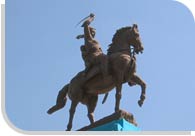Agra Tour

Varanasi Tour

Fatehpur Sikri Tour

Fairs and Festivals

Mathura Tour


Jhansi- The Lionhearted City of the Courageous Queen
 The patriotic city of Jhansi is synonymous to the Rani of Jhansi, Lakshmi Bai. The city is known for the Sepoy Mutiny and resistance against the British in 1857. Located 103 km from Gwalior and 175 km from Khajuraho, Jhansi got its name from the term 'jhain-si' which means blurred shadow. Formerly known as Shankargarh, Jhansi was a stronghold of the Chandela kings. Situated between the Betwa and Pahunj rivers, Jhansi serves as a gateway to Bundelkhand.
The patriotic city of Jhansi is synonymous to the Rani of Jhansi, Lakshmi Bai. The city is known for the Sepoy Mutiny and resistance against the British in 1857. Located 103 km from Gwalior and 175 km from Khajuraho, Jhansi got its name from the term 'jhain-si' which means blurred shadow. Formerly known as Shankargarh, Jhansi was a stronghold of the Chandela kings. Situated between the Betwa and Pahunj rivers, Jhansi serves as a gateway to Bundelkhand.
It is the place from where Rani Lakshmi Bai led her troops in the 1857 war against the British for independence. The city was given to Jiyaji Rao Scindia by the British Government in 1861. Jhansi was then a part of Gwalior state. But in 1886, the British took Jhansi back from Gwalior state. It was later in independent India that Jhansi was included in Uttar Pradesh. Presently it serves as a Divisional Commissioner's Headquarter including district Jhansi, Lalitpur and Jalaun.
Jhansi Fort
A major stronghold during the Sepoy mutiny of 1857, this majestic fort was built by Raja Bir Singh Ji Deo, in 1613. The fort was transferred to the maharaja of Scindia in 1858, but later exchanged for Gwalior in 1866. Being located on a rocky hill, it offers wonderful views of the city. This huge fort, with ten gates, was built in order to act as an army stronghold and garrison but was later modified into residential quarters. The fort also has a museum, which is known for a wonderful collection of sculptures and provides an excellent insight into the lively history of Bundelkhand. A statue of the queen (Lakshmi Bai) is also installed on the way to the fort.
Jhansi Museum
Jhansi Museum or the Government Museum is popular for an interesting collection of prehistoric tools and literature. It is broadly divided into four galleries that comprise of terracottas dating from the 4th century BC, sculptures, costumes, weapons from the Chandela dynasty, arms, manuscripts, paintings and coins of gold, silver and copper. The Jhansi museum is located in the Jhansi Fort itself. The museum gives a deep insight into the Chandela dynasty. One can also see a separate picture gallery dedicated to the Gupta Kings, which is the major highlight of this museum.
Rani Mahal
This 18th century structure was once the palace of Rani Lakshmi Bai. Refurbished as a museum, it contains hundreds of sculptures dating back to the 9th and12th century. The Rani Mahal is basically a double storied structure with flat roofs, arched chambers and open courtyards. The second floor has a huge Durbar Hall that features an original painted wood-paneled ceiling. It has a total of six grand halls with parallel verandas. The most exciting feature of the palace lies in its multi-colored paintings on the walls and ceilings. Rani Mahal has been witness to the Great Sepoy Mutiny of 1857. It was the place where Lakshmi Bai made plans with Tantya Tope and Nana Sahib to overcome the colonial rule.
Each place and monument of the city reminds one of the bloodbath of 1857. The city is well connected to all the major cities of India via National Highways 25, 26 and 3.
 Classical North India
Classical North India Classical North India+Nepal
Classical North India+Nepal Buddhist Pilgrimage Tour
Buddhist Pilgrimage Tour Rajasthan with Classical India & Kathmandu
Rajasthan with Classical India & Kathmandu